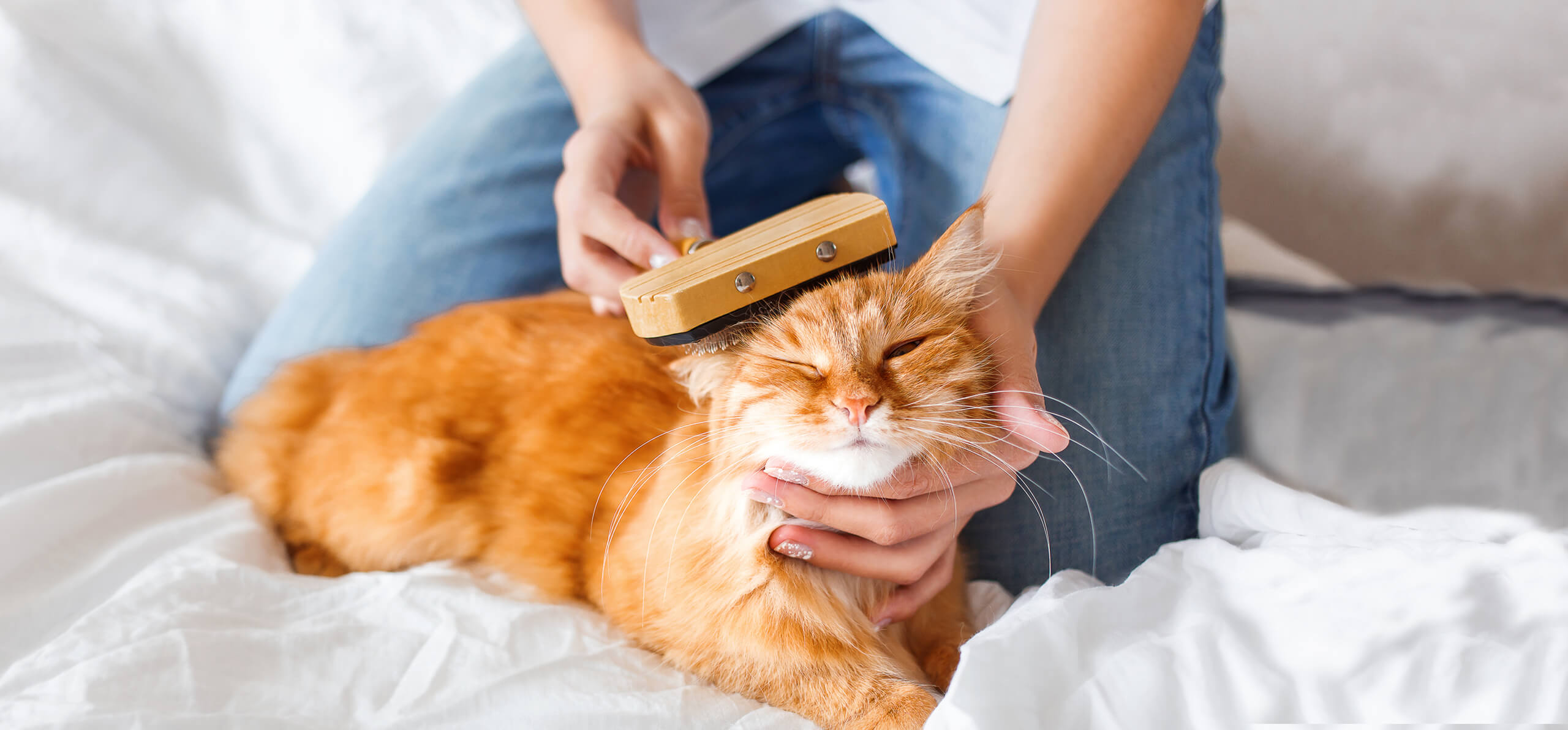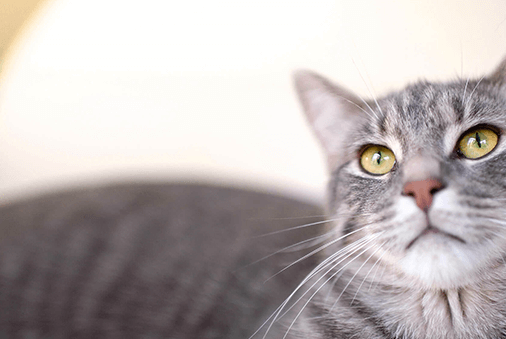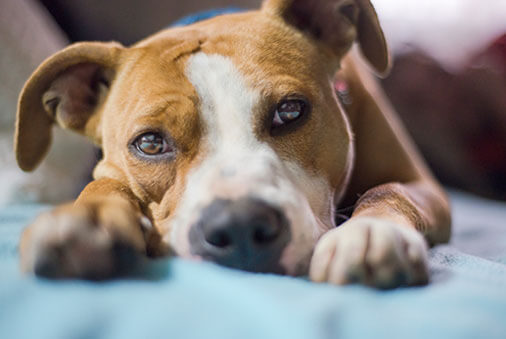It’s also an ideal time to examine your dog or cat’s body for fleas, ticks, skin irritations, lumps or sore spots. You’ll also want to check their ears, eyes and teeth regularly and talk to your vet about anything that may be unusual.
Because the health and well-being of our four-legged family members is as important to us as it is to you, we wanted to provide you with some information to help you keep your dog or cat at his or her best—with valuable tips, common sense advice and important insights into providing them with the best grooming care possible.
Dog Grooming Care
Proper grooming of your dog really comes down to four areas—coat, nails, teeth and ears.
Coat
It’s recommended that you brush your dog’s coat every day. Doing so will help keep his hair in good condition by removing dirt, while spreading his natural oils throughout his coat. You’ll also be helping to prevent tangles from forming and keeping his skin clean and free from irritation. Long-haired dogs need to be groomed daily, while short-haired breeds may only need one session per week. Pick a time when your dog is relaxed, such as after walking, and when you have sufficient time.
Although there are many different shapes and sizes, there are basically three different brush types—bristle brushes, wire-pin brushes and slicker brushes. When choosing a brush for your dog, consider his breed and coat type:
Bristle brushes can be used on all coat types. In general, the longer the coat, the more widely spaced and longer the bristles should be. Also, the coarser the hair, the stiffer those bristles need to be.
Wire-pin brushes, with or without rubber-tipped ends, are the preferred choice for pets with medium to long hair and those with curly or woolly coats.
Slicker brushes have fine wire bristles and are especially useful for removing mats and tangles.
Rubber combs are also effective at massaging the skin and removing dead hair from short-haired breeds. It is also a good idea to have a grooming rake to get to your dog’s undercoat to remove mats or dead hair.
Brush in the direction of hair growth, beginning at the head, and work towards the tail and down the legs. It is best to start brushing your pet at an early age. You want to make this a fun, enjoyable experience so go slowly and be sure to praise and reward him with plenty of treats.
Bathing
You’ll want to bathe your dog once every two months or as often as needed. Be sure to brush him before each bath in order to get all of the mats out of his coat.
Bathing Tips
- Place a rubber mat in your bathtub, or a towel in your sink, for secure footing. Then place a cotton ball in each of your dog’s ears to prevent water from entering.
- Rinse him with warm water. Use a spray hose if one is available but be sure to keep the nozzle very close to your dog’s body. Never spray him in the face.
- Apply a shampoo in small amounts, working from the head to the tail.
- Be sure to clean his backside, between the toes, behind the ears and under the chin. Try to avoid getting shampoo in your dog’s eyes.
- Thoroughly rinse your pet with warm water.
- Dry your dog with a towel and/or hair dryer.
Nails
Clipping your dog’s nails is important—long nails can really hamper his ability to get around. You should trim your pet’s nails about once per month. You’ll need a clipper designed specifically for the kind of dog you have—either a scissor or guillotine-style clipper can be used. You should also purchase a small bottle of blood-clotting powder.
Nail Clipping Tips
- Gradually shorten one nail. Be sure to stop before you reach the quick, which is the part of the nail that contains nerves and blood vessels.
- If you cannot see the quick clearly, stop cutting just behind the point at which the nail begins to curve downward.
- If you cut into the quick, do not panic. Put some clotting powder on a moist cotton swab and press it firmly against the nail for several seconds. It should stop any bleeding.
Ears
Ear care is an important part of grooming. Ear infections not only can be painful, but also can lead to permanent hearing loss. The signs of a problem with your dog’s ears include redness, constant scratching, head shaking and odor.
Cleaning Your Dog’s Ears
- Check your dog’s ears twice per month. The skin inside and on the flaps should be pale pink. If there is a foul odor and/or any red, brown or black skin, have a veterinarian examine his ears.
- Moisten a cotton ball with warm water or a little mineral oil and use it to clean the opening into the canal and the flaps. Do not go too far into the canal.
Teeth
Dogs can get cavities and develop periodontal disease, so their teeth should be cleaned with a pet toothpaste at least twice per week. It is best to use a small toothbrush that has soft bristles. You may also need a veterinarian to do a periodic cleaning, too.
Cat Grooming Care
Because cats do a lot of their own grooming, they don’t need as much help as dogs. The most important thing you can do is brush her. How often? It depends on the length of her coat.
- A cat with a very short, single coat similar to the Siamese, Burmese and Cornish Rex needs very little grooming.
- The dense-coated short-haired cats like American shorthairs, British shorthairs and Scottish folds require a monthly grooming session.
- Semi-longhaired cats resembling Maine Coons should be combed and bathed even more regularly.
- Cats with long, flowing coats resembling the Persian should be combed and have their faces cleaned at least every other day, and they should be bathed weekly or bi-weekly. Their ears should also be cleaned.
Tips for Combing and Brushing Your Cat
Without proper brushing, cats will be subjected to shedding, a greasy consistency to their fur and matting. Remember to comb gently from front to back and reassure your cat with a soothing voice. Do this as much as needed to keep shedding and knots to a minimum. Combs and brushes should be selected based on her type of coat. In general, your brush should remove dry, dead skin from your cat’s coat along with the excess hair while distributing the natural oils in her coat.
Hard brushes are an ideal choice to keep the dense coats of short-hair cats from knotting and soft brushes can be used effectively on cats with short, sleek coats.
Pin or wire brushes are the ideal choice (along with combs) to keep longhair cats’ coats from knotting.
Palm-held rubber brushes are another alternative if your cat has an aversion to regular brushes. These small brushes are easily concealed in your hand and enable you to groom your cat while petting her.
If you have a senior cat that is sensitive to the wire brushes, look for a brush that has plastic tipped teeth. This may be more comfortable next to the skin for your older cat.
Taking Care of Mats
The dreaded mat can form on even the most well-groomed cats, especially during seasonal shedding. If you find these clumps of dried, tangled hair in your cat’s fur, never try to cut them out because you could slip and cut your cat's skin. It is better to work out a mat with a grooming comb.
- With one hand, try to hold the hair as close to its base as possible without pulling directly on the cat’s skin.
- Hold the grooming comb in your other hand and use the tip to pick at the mat gently until it begins to loosen up.
- As it starts to break apart from the coat, it can easily be combed out.
Bathing Your Cat
Sometimes greasy coats, allergies and plain old dirt require a cat to have a good bath. This can be tricky because cats don’t like water—in fact, they usually loathe it.
Cleaning Your Cat’s Eyes
Eye matter can be a problem in big-eyed, short-nosed cats—breeds like the Persian that have that "mushed-in" look to their faces.
- To clean the eyes use a soft washcloth or a cotton square dipped in tepid water.
- Hold your cat’s head and wipe the damp cloth gently across her lower eyelid. Be careful not to rub the eyeball directly.
- Let the moisture soften the eye matter and then go back and wipe again. Make sure you use a fresh section of the cloth each time.





